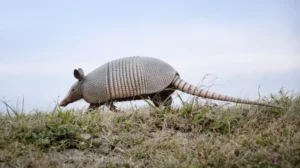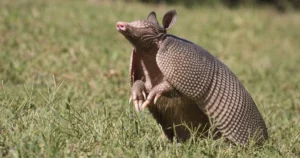
The state of Texas is known for its diverse wildlife, and one unique creature that captures the imagination is the nine-banded armadillo. These fascinating mammals have a rich history in the Lone Star State, and their behaviors and characteristics make them truly intriguing. In this article, we will delve into the world of nine-banded armadillos, exploring their unique armor, how they got their name, their historical presence in Texas, the impact they have on ecosystems, the risks they pose, and effective methods for their removal.

One of the most striking features of the nine-banded armadillo is its armor, which consists of hard, bony plates known as scutes. These scutes cover the head, body, and tail of the armadillo, providing it with excellent protection against predators. Interestingly, these scutes are made of the same material as our fingernails - keratin.
In addition to their unique armor, nine-banded armadillos are known for their ability to roll into a ball when threatened. This behavior, known as "balling up," allows them to safeguard their vulnerable underbelly from potential predators.
But let's dive deeper into the fascinating world of the nine-banded armadillos and explore their armor in more detail.
The armor of the nine-banded armadillo is composed of overlapping plates of bone covered with keratin. This structure provides both flexibility and strength, allowing the armadillo to move freely while still being protected. Each plate is connected by a tough, elastic skin, enabling the armadillo to curl up tightly when necessary.
Imagine the intricate design of these plates, perfectly overlapping to create a shield that shields the armadillo from harm. The keratin covering adds an extra layer of durability, ensuring that the armor remains intact even in the face of potential threats.
While the armor is essential for their survival, it also poses some challenges. It limits the armadillo's flexibility, making it difficult for them to swim or climb. As a result, nine-banded armadillos primarily rely on their powerful digging abilities to survive.
These remarkable creatures have evolved to adapt to their environment, utilizing their unique armor as a defense mechanism and tool for survival.

Despite their name, nine-banded armadillos actually have between seven and eleven bands on their armor. The average number of bands across their back is nine, hence the name. This number can vary depending on the armadillo's age, sex, and body condition.
It's fascinating to think about how these armadillos were named by early Spanish explorers who noticed the unique segmented structure of their armor. The explorers were captivated by the intricate patterns created by the overlapping plates, and the name "nine-banded armadillo" stuck. It's a testament to the lasting impact of their discovery.
While not all nine-banded armadillos have precisely nine bands, the name has become synonymous with this remarkable species. It serves as a reminder of the rich history and exploration that has shaped our understanding of the natural world.
Armadillos have a long-standing presence in the state of Texas, with the nine-banded species being native to the region. They have roamed the plains, forests, and urban areas of Texas for thousands of years. The armadillo's ability to adapt to various environments has contributed to its thriving population within the state.
Armadillos, with their unique armored shells and peculiar appearance, have fascinated both locals and visitors alike. These fascinating creatures have become an integral part of Texas culture, inspiring artwork, literature, and even local festivals dedicated to celebrating their presence.
Long before Texas became a state, the nine-banded armadillo was already a part of the local fauna. Native tribes revered these creatures, incorporating them into their folklore and even utilizing their shells for various purposes. The armadillo's symbolic significance in indigenous cultures is a testament to its deep-rooted connection with the land.
As European settlers arrived in Texas, they encountered the armadillo for the first time. Fascinated by this peculiar creature, they documented their observations and shared stories of their encounters. These early accounts helped spread knowledge and awareness about the armadillo's presence in Texas.
The arrival of European settlers did not disrupt the armadillos' presence in Texas. Instead, they adapted to the changing landscape, finding their way into agricultural fields and suburban neighborhoods. Today, they are just as much a part of Texas culture as they were centuries ago.
The presence of nine-banded armadillos has both positive and negative impacts on Texas ecosystems. On the positive side, these armadillos aid in controlling populations of insects, especially ants and termites, as they are integral parts of their diet. Their foraging behavior helps maintain a balance in the ecosystem by controlling pest populations.
Armadillos also play a crucial role in seed dispersal. As they dig through the soil in search of food, they inadvertently transport seeds to new locations, contributing to the spread of plant species. This process promotes biodiversity and helps sustain the overall health of Texas ecosystems.
However, armadillos' digging habits can disrupt soil structure and damage plant roots, particularly in areas where their population density is high. Some conservationists express concerns about the potential impacts on rare plant species and vulnerable ecosystems. Striking a balance between conservation efforts and managing the armadillo populations poses an ongoing challenge.
Despite the challenges they pose, armadillos remain an iconic species in Texas, captivating the imagination of both scientists and nature enthusiasts. Ongoing research and conservation efforts aim to better understand their ecological role and find innovative solutions to mitigate any negative impacts they may have on the environment.

While nine-banded armadillos might seem harmless, they do pose risks in certain situations. It's essential to be aware of these risks to ensure the safety and well-being of both humans and armadillos.
Armadillos, native to Texas, are fascinating creatures with unique characteristics. They have a protective armor-like shell made of bony plates, which acts as a shield against predators. However, despite their intriguing nature, there are important considerations to keep in mind when encountering these animals.
One notable risk associated with armadillos is their potential to transmit diseases to humans. They are natural hosts for the bacteria that causes leprosy, a rare infectious disease. Although the transmission of leprosy from armadillos to humans is uncommon, caution should be exercised when handling armadillos or being in close proximity to them.
Armadillos are not the only animals that can transmit diseases. Many wild animals, including rodents and birds, can also carry pathogens that pose risks to human health. It is crucial to be aware of these potential risks and take necessary precautions when interacting with wildlife.
To reduce the risk of disease transmission, it is crucial to avoid direct contact with armadillos, especially if they are dead or showing signs of illness. Simple hygiene practices, such as thorough handwashing after potential exposure, can help mitigate any potential risks.
It's important to note that armadillos play a vital role in the ecosystem by controlling insect populations. They feed on insects, including ants, termites, and beetles, helping to maintain a balance in nature. Despite the risks associated with disease transmission, it is crucial to appreciate the ecological contributions of these unique creatures.
Armadillos are known for their habit of crossing roads, which can lead to unfortunate encounters between them and vehicles. Collisions with armadillos not only pose risks to the drivers but also result in harm to the armadillos themselves.
Motorists in Texas should exercise caution when driving through areas known to have armadillo populations. It is advisable to slow down and remain vigilant, particularly during nighttime when armadillos are most active. By doing so, we can help minimize the risks to both armadillos and drivers.
It's interesting to note that armadillos have poor eyesight, relying primarily on their sense of smell to navigate their surroundings. This, coupled with their slow movement, makes them more vulnerable to road accidents. By understanding their behavior and taking necessary precautions, we can coexist with these unique animals while ensuring their safety and our own.
In conclusion, while armadillos may appear harmless at first glance, it is important to be aware of the risks they can pose. By understanding the potential for disease transmission and being cautious on the roads, we can ensure the well-being of both humans and armadillos in Texas.
Effective Methods for Armadillo Removal
In situations where armadillos become pests, it may be necessary to explore methods for their removal. It is important to prioritize humane practices and consider seeking professional assistance when needed.
For individuals facing armadillo-related issues on their properties, employing humane removal techniques can be a viable option. Using exclusion tactics, such as installing fencing or modifying the landscape to deter armadillos, can help mitigate conflicts.
Additionally, providing alternative food sources away from human-inhabited areas can help redirect armadillos' foraging behaviors. By ensuring that armadillos can find ample food in designated areas, their impact on residential spaces can be minimized.
In cases where armadillo populations become overwhelming or the situation requires professional expertise, seeking assistance from wildlife removal services is recommended. These professionals have experience in safely and humanely trapping and relocating armadillos, ensuring the safety and welfare of both the animals and humans involved.
It is essential to remember that removing armadillos should be done in accordance with local laws and regulations. These guidelines help protect both the armadillos and the ecosystem in which they reside.
The nine-banded armadillo, with its unique armor and ability to adapt to various environments, has carved a place for itself in the fascinating world of Texas wildlife. Understanding their history, impact, and risks associated with them allows us to appreciate them while also taking the necessary precautions for coexistence. By implementing effective removal techniques, we can strike a balance between harmonious living and managing armadillo populations. So, the next time you catch a glimpse of a nine-banded armadillo wandering through the Texas landscape, take a moment to appreciate the remarkable creature that it is.